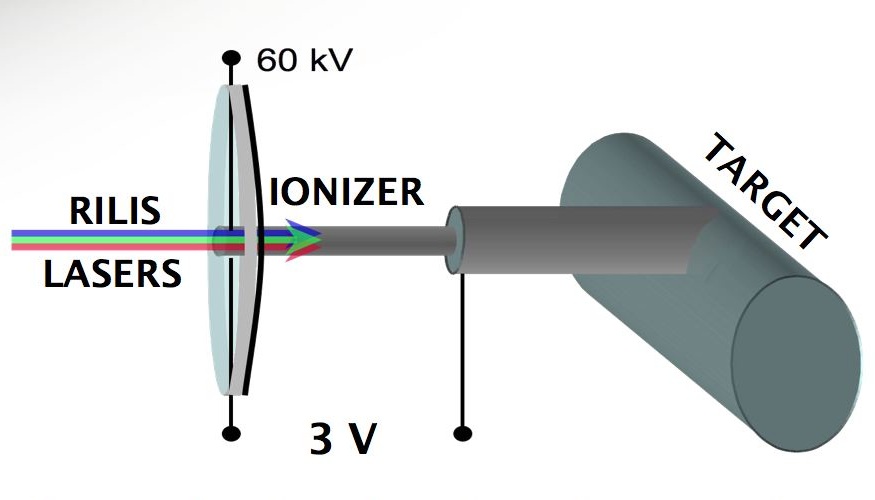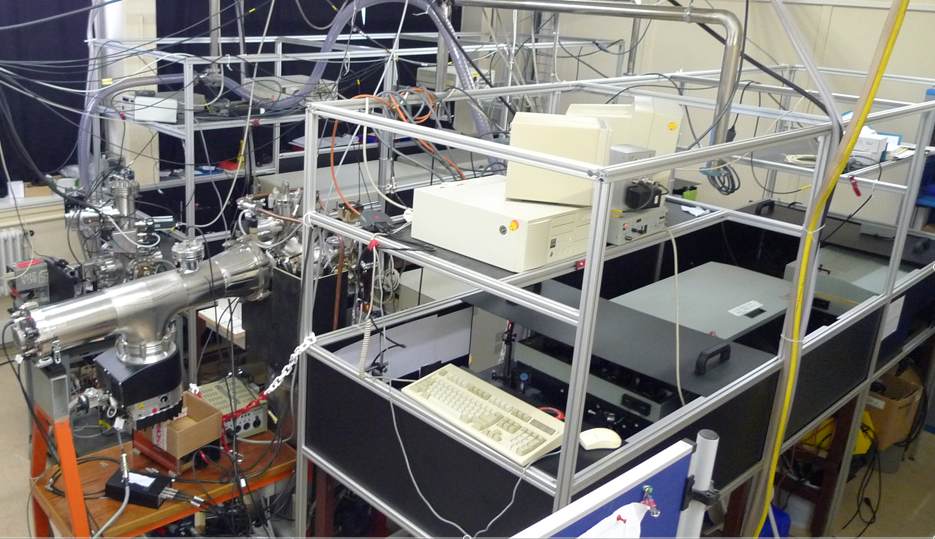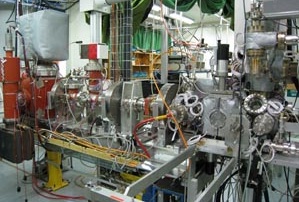
Engineering : Sources, Targets and Interactions : Lasers and Photocathodes
The EN-STI/LP Section - Lasers and Photo-cathodes
Activities
- Operation and development of laser based particle sources, in particular the RILIS (Resonance Ionization Laser Ion Source) and the photo-injectors of CTF3.
- The section maintains a high-level know-how on high power pulsed lasers, and on development of photocathodes for high charge and high brightness photo-injectors.
- Involvement in the international effort to develop a polarized positron source for the CLIC study.
- Participation in european and international networks for R&D on new materials and laser technology for applications to particle sources.
RILIS
 The Resonance Ionization Laser Ion Source (RILIS) at the ISOLDE on-line isotope separator is a chemically selective ion source which relies on resonant excitation of atomic transitions by tunable laser radiation. In total, isotopes of 28 different elements have been selectively laser-ionized and separated at ISOLDE.
The Resonance Ionization Laser Ion Source (RILIS) at the ISOLDE on-line isotope separator is a chemically selective ion source which relies on resonant excitation of atomic transitions by tunable laser radiation. In total, isotopes of 28 different elements have been selectively laser-ionized and separated at ISOLDE.
LARIS
 Operating independently of the on-line RILIS setup, the LARIS laboratory is capable of providing extensive data on atomic transitions, in particular between highly excited and auto-ionizing atomic states, which are required for the improvement of the RILIS efficiency.
Operating independently of the on-line RILIS setup, the LARIS laboratory is capable of providing extensive data on atomic transitions, in particular between highly excited and auto-ionizing atomic states, which are required for the improvement of the RILIS efficiency.
Photo-emission Laboratory
 The mandate of the Photo-emission Laboratory is to study and produce photo-cathodes for high intensity electrons sources known as photo-injectors. The work-horse of the lab is the production of Cs2Te photo-cathodes in co-evaporation techniques. The laboratory is fitted with a preparation chamber for the photo-cathode fabrication, a 100 kV DC gun and a measurement line for electron beam production during photo-cathode characterization. A transport carrier is able to send, under UHV conditions, our photo-cathodes to the other CERN photo-injector facility. Finally, two industrial lasers are used for UV light illumination required during photo-cathode production and characterization.
The mandate of the Photo-emission Laboratory is to study and produce photo-cathodes for high intensity electrons sources known as photo-injectors. The work-horse of the lab is the production of Cs2Te photo-cathodes in co-evaporation techniques. The laboratory is fitted with a preparation chamber for the photo-cathode fabrication, a 100 kV DC gun and a measurement line for electron beam production during photo-cathode characterization. A transport carrier is able to send, under UHV conditions, our photo-cathodes to the other CERN photo-injector facility. Finally, two industrial lasers are used for UV light illumination required during photo-cathode production and characterization.
The CTF3 Photo-injector Laser
 The CLIC Test Facility (CTF) requires the use, study and development of a photo-injector laser. The high quality Cs2Te photocathode currently produced in the photoemission laboratory is illuminated by UV laser pulses to generate electron emission. CTF is a collaboration driven by CERN which aims to demonstrate the feasibility of the future multi-TeV linear collider. The unique two beam acceleration scheme requires a main beam and a drive beam for which respectively CALIFES and PHIN facilities have been set up, for which the feasibility of the photo-injector is being tested. The machines require from single pulse to 1.2 us long pulse trains, known as macropulses, of high power, high stability UV laser radiation with a complicated time-structure based on the 1.5 GHz mode-locked frequency. The state-of the art laser system designed at RAL and developed at CERN includes a master oscillator synchronized to the RF of the electron gun, a CW and two high power pulsed solid-state diode-pumped amplifiers running at a repetition rate of 1-50 Hz. The macro pulse envelopes are sliced out from the IR beam by fast electro-optical switches and then converted into the required UV wavelength through two harmonic generation stages. Electron energies up to 5.4 MeV are produced by the RF gun.
Laser development continues in the following areas: High power amplification at 1047 nm using Nd:YLF; pulse timing structure using fast optical switches; high efficiency, high average power harmonic generation; active feedback stabilization.
The CLIC Test Facility (CTF) requires the use, study and development of a photo-injector laser. The high quality Cs2Te photocathode currently produced in the photoemission laboratory is illuminated by UV laser pulses to generate electron emission. CTF is a collaboration driven by CERN which aims to demonstrate the feasibility of the future multi-TeV linear collider. The unique two beam acceleration scheme requires a main beam and a drive beam for which respectively CALIFES and PHIN facilities have been set up, for which the feasibility of the photo-injector is being tested. The machines require from single pulse to 1.2 us long pulse trains, known as macropulses, of high power, high stability UV laser radiation with a complicated time-structure based on the 1.5 GHz mode-locked frequency. The state-of the art laser system designed at RAL and developed at CERN includes a master oscillator synchronized to the RF of the electron gun, a CW and two high power pulsed solid-state diode-pumped amplifiers running at a repetition rate of 1-50 Hz. The macro pulse envelopes are sliced out from the IR beam by fast electro-optical switches and then converted into the required UV wavelength through two harmonic generation stages. Electron energies up to 5.4 MeV are produced by the RF gun.
Laser development continues in the following areas: High power amplification at 1047 nm using Nd:YLF; pulse timing structure using fast optical switches; high efficiency, high average power harmonic generation; active feedback stabilization.
Section Leader
Valentin FedosseevPersonnel
Eric ChevallayDaniel Fink
Thomas Day Goodacre
Christoph Hessler
Bruce Marsh
Irene Martini
Mikhail Martyanov
Ralf Rossel
Sebastian Rothe